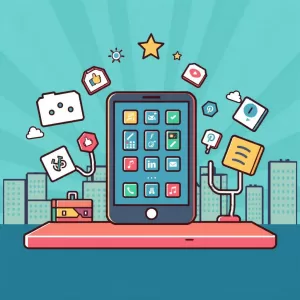Software as a Service (SaaS): Trends and Opportunities
Introduction 🚀
Software as a Service (SaaS) is dominating the tech industry, with businesses shifting from traditional software to cloud-based solutions. By 2025, the SaaS market is expected to be worth over $900 billion, making it one of the fastest-growing sectors in technology.
But what’s next for SaaS? 🤔
In this article, we’ll explore the following:
- First, we’ll look at key SaaS trends shaping the future, helping businesses adapt to the changing landscape.
- Next, we’ll dive into the emerging technologies driving innovation, offering fresh ways to enhance business operations.
- Additionally, we’ll discuss the opportunities for startups and developers, which are abundant in the growing SaaS market.
- Finally, we’ll explore how businesses can leverage SaaS for growth, boosting efficiency and scalability.
Let’s dive in! 🔍
1️⃣ The Rise of AI-Driven SaaS
Artificial Intelligence (AI) is making SaaS platforms smarter, faster, and more efficient. From automating workflows to personalized customer experiences, AI is revolutionizing the SaaS industry.
🔹 How AI is Transforming SaaS
Here are some of the key AI-driven advancements in SaaS:
- Automated Workflows: AI eliminates repetitive tasks, allowing employees to focus on higher-value work and boosting overall productivity.
- AI-Powered Analytics: These tools now predict trends and customer behavior, helping businesses make data-driven decisions.
- Intelligent Chatbots: AI-driven customer support systems improve response times, offering quick and efficient service to customers.
💡 For example, AI-powered Software as a Service (SaaS) tools like HubSpot and Salesforce use machine learning to suggest personalized marketing strategies.
2️⃣ Vertical SaaS: Industry-Specific Solutions
Instead of general-purpose software, companies are shifting towards Vertical SaaS—specialized SaaS solutions built for specific industries like healthcare, finance, and education.
🔹 Popular Vertical Software as a Service (SaaS) Solutions
Popular SaaS Solutions:
- FinTech SaaS: Digital banking platforms like Stripe and PayPal are revolutionizing financial transactions. These platforms, for instance, offer seamless payment processing and financial services, simplifying operations for both businesses and individuals.
- HealthTech SaaS: Telemedicine software like Teladoc Health is improving access to healthcare services. In fact, these tools enable remote consultations and streamline healthcare operations, making medical care more accessible and efficient.
- EdTech SaaS: Online learning platforms such as Udemy and Coursera are transforming education. These platforms provide a wide range of courses and certifications, making education more accessible to learners worldwide.
By adopting these solutions, businesses are able to innovate and improve their services across various sectors.
💡 Why It Matters: Businesses prefer customized solutions tailored to their industry, leading to more niche SaaS startups.
3️⃣ The Growth of No-Code & Low-Code Software as a Service (SaaS) Platforms 🏗️
No-code and low-code development are empowering non-technical users to build apps without the need for programming skills. As a result, this trend is making SaaS more accessible to startups and small businesses, allowing them to create tailored solutions quickly and affordably.
🔹 Popular No-Code SaaS Platforms
Here are some popular no-code SaaS platforms that are making waves in the industry:
- Bubble: This platform allows users to build web apps with drag-and-drop functionality, making it easy for non-technical users to create complex applications without writing any code.
- Zapier: With Zapier, users can automate workflows without the need for coding. It integrates apps and services, streamlining tasks by connecting different platforms to work together seamlessly.
- Airtable: Airtable combines the simplicity of spreadsheets with the functionality of databases. This powerful platform lets users manage and organize data in a more dynamic and customizable way.
These platforms are helping businesses and individuals create sophisticated solutions with minimal technical expertise, thus expanding the potential for innovation across different industries.
💡 Why It’s Important: Small businesses can now build custom SaaS tools without hiring developers!
4️⃣ Software as a Service (SaaS) and the Subscription Economy
The subscription model has become the standard for SaaS businesses, offering customers flexibility and scalability. Companies now prefer monthly or yearly plans instead of one-time software purchases.
🔹 Key Benefits of the Subscription Model
Here are the key benefits of the subscription model:
- Predictable revenue streams: Subscription models offer businesses a more predictable flow of income. As a result, they can forecast earnings with greater accuracy and plan ahead for future growth.
- Better customer retention: With regular updates, ongoing support, and the continuous value of the service, subscription-based models naturally help keep customers engaged. This, in turn, leads to stronger, long-term relationships.
- Lower upfront costs: Unlike traditional models that require large one-time payments, subscription services have lower initial costs. This makes them more accessible for small businesses and startups, allowing them to invest in tools and services without financial strain.
These benefits make the subscription model an attractive choice for both businesses and consumers, fostering a more stable and sustainable business environment.
💡 For example, Netflix, Spotify, and Adobe thrive on subscription-based models instead of one-time purchases.
5️⃣ The Future of SaaS Security & Compliance
As SaaS adoption grows, cybersecurity threats and data privacy concerns are on the rise. Consequently, companies must now prioritize enhanced security measures to safeguard user data.
🔹 Key Security Trends in SaaS
Here are the key security trends in SaaS:
- Zero Trust Architecture: This approach continuously verifies users and devices, ensuring only authorized individuals can access the system. By treating every access attempt as potentially suspicious, it mitigates the risk of both internal and external threats.
- End-to-End Encryption: Sensitive customer data is encrypted at all stages, from transmission to storage, making it nearly impossible for unauthorized parties to access or intercept it.
- Regulatory Compliance: SaaS providers are increasingly focusing on complying with global data protection regulations such as GDPR, HIPAA, and other industry-specific laws. This ensures that customer data is handled responsibly and securely, maintaining trust and reducing legal risks.
These security trends are essential for maintaining the integrity and confidentiality of data while helping SaaS providers build trust with their customers.
💡 What This Means: SaaS companies must invest in cybersecurity solutions to maintain trust and prevent breaches.
6️⃣ Multi-Cloud and Hybrid Software s a Service (SaaS) Adoption
Companies no longer rely on a single cloud provider. Instead, they use multi-cloud and hybrid cloud strategies to increase flexibility and reduce dependency on one vendor.
🔹 SaaS Deployment Models
Here are the key SaaS deployment models:
- Single-Cloud SaaS: In this model, the SaaS solution is hosted on a single cloud provider, such as AWS or Google Cloud. It’s typically simpler and cost-effective, as it relies on the infrastructure of one provider.
- Multi-Cloud SaaS: This model utilizes multiple cloud providers to ensure redundancy and avoid dependency on a single vendor. It enhances reliability, scalability, and risk management by distributing resources across different cloud platforms.
- Hybrid SaaS: A combination of on-premise and cloud solutions, hybrid SaaS is ideal for industries that require strict data security and regulatory compliance, such as healthcare and finance. This model allows sensitive data to be kept on-premise, while less critical processes are managed in the cloud.
These deployment models offer different levels of flexibility, security, and scalability, allowing businesses to choose the best fit for their needs.
💡 For example, Netflix runs on multiple cloud providers to ensure uptime and performance stability.
7️⃣ Future Opportunities for SaaS Startups
The SaaS industry is experiencing rapid growth, creating exciting opportunities for startups and developers. If you’re planning to enter this thriving space, here are some high-potential areas to consider:
- AI-Powered SaaS: These smart automation tools are revolutionizing how businesses operate. As a result, they streamline processes and enhance decision-making through advanced AI capabilities.
- Micro-SaaS Niches: These are focused, small-scale SaaS solutions catering to specific industries or needs. Consequently, they are gaining traction for their ability to address niche markets with personalized, high-value offerings.
- SaaS for Remote Work: With the rise of remote work, virtual collaboration and productivity tools have become in high demand. These platforms, therefore, help teams stay connected and efficient, no matter their location.
- Green SaaS: These cloud-based solutions focus on sustainability. As a result, businesses are increasingly turning to eco-friendly SaaS solutions to minimize their carbon footprint, especially given the growing concern for the environment.
By focusing on these rapidly evolving trends, startups can tap into emerging needs and drive long-term growth in the SaaS sector.
💡 What This Means: Entrepreneurs who innovate in these areas will have huge opportunities for success.
Conclusion: Software as a Service (SaaS) is the Future of Software!
The SaaS industry is evolving rapidly, driven by AI, automation, and industry-specific solutions. Businesses that adopt SaaS early will gain a competitive advantage, while startups have endless opportunities to innovate.
💡 Final Thought: Whether you’re a developer, entrepreneur, or business owner, staying ahead of SaaS trends will help you succeed in the future of software development.
Ready to start your SaaS project in the cloud? Contact Teknikali Tech today.
🔥 What do you think? Which SaaS trend excites you the most? Let us know in the comments! ⬇️
Share this content:







Post Comment